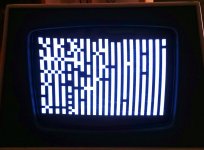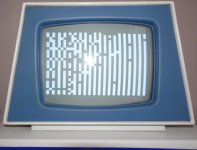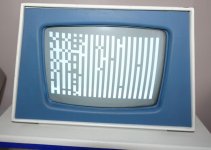I've just acquired a PET 2001 with chiclet keys .
When powering on, it hums and displays nothing but these solid blocks (which do not change position or shape.)

There is nothing missing from the logic board and it came from the original owner who never modified or attempted to repair it.
Tried already : swapping RAM, swapping video ROM. This slightly altered what was on screen but did not fix it.
Doesn't get any further, datasette doesn't operate, no response from keys... I've seen the usual garbage screen before, on other PETs, but never this blocks one.
any clues?
When powering on, it hums and displays nothing but these solid blocks (which do not change position or shape.)

There is nothing missing from the logic board and it came from the original owner who never modified or attempted to repair it.
Tried already : swapping RAM, swapping video ROM. This slightly altered what was on screen but did not fix it.
Doesn't get any further, datasette doesn't operate, no response from keys... I've seen the usual garbage screen before, on other PETs, but never this blocks one.
any clues?
Last edited:


